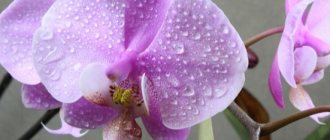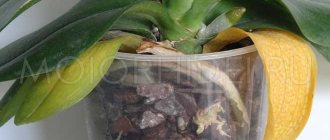Phalaenopsis are often touted as nearly year-round blooming orchids. It’s true that they can be found on shelves at any time of the year and can put on an amazing marathon, but they still bloom intermittently. Phalaenopsis have no dormant period; they vegetate constantly, blooming on average twice a year, and each time for two to four months. It is almost impossible to accurately predict flowering; the timing is influenced by dozens of micro-factors. The correct “pause” between flowering is ensured mainly by care. For the rest, it’s better to trust nature and the plant itself.
The dormant period of phalaenopsis - when to expect flowering?
Life cycle
First, the orchid actively grows green mass and root system. To enter the flowering stage, it needs a full rosette of 5-8 strong leaves . It takes from 1.5 to 3 years to form and strengthen the roots.
The flowering period lasts from 3 to 10 months. At this point, foliage and root growth slows down. It will resume after the plant has flowered and remains dormant for 2-3 months. Then the formation of new flower stalks will begin.
Brief description of care
Briefly about the most important points when caring for phalaenopsis:
- Temperature and humidity . The temperature should not fall below +15°C. Humidity is about 50-60%.
- Illumination . The light should be bright, but diffused; a slight shadow is allowed.
- Watering . Only after the substrate has completely dried. Water should not get into the axils of the leaves.
- The soil . The substrate is based on pine bark and peat.
- Trimming . The old stem is cut off after flowering.
- Rest period . Poorly expressed.
- Bloom . It blooms twice a year, with a short dormant period.
- Feeding . Fertilizing is combined with watering, using complete mineral fertilizer for orchids.
- Transplant . Once every 2-3 years.
What is needed for flowers to appear?
For normal development and growth of the orchid, it is necessary to maintain an appropriate microclimate in the room. The plant will bloom profusely if you adhere to the following recommendations :
- Use only transparent containers for growing phalaenopsis. Its root system also takes part in photosynthesis, so they need constant access to light.
- Do not plant the flower in pots with embossed walls or sharp corners, otherwise the roots will grow to the uneven surface or may be injured.
- Choose a permanent place for the container with the orchid and do not move it even during watering. Moving causes stress and slows down metabolic processes.
- Provide sufficient lighting. The duration of daylight should be at least 10-12 hours. In the cold season, its deficiency is compensated for by phytolamps, which provide bright light, but do not dry out the air near the flower and do not overheat it.
- Maintain humidity levels between 60-70%. If the room is too dry, place a glass of water near the pot or spray the leaves with a spray bottle.
Reference . When bred at home, phalaenopsis blooms mainly in the cold season. Its flowering period lasts from November to March-April.
Reasons for absence
Healthy orchids do not produce flower stalks for several reasons.:
- they have not yet reached adulthood;
- the indoor microclimate is too comfortable - without a difference in night and day temperatures, as in nature;
- lacks nutrients.
Knowing what exactly prevents flowering, you can easily correct the situation. Sometimes it’s enough just to wait for the plant to grow or feed it.
When not to fertilize
Feeding is strictly contraindicated in the following cases:
- A newly purchased or gifted flower should be given at least 2 weeks time to adapt and only then begin caring for it according to all the rules.
- Immediately after the transplant. No matter how carefully the plant is transshipped, the roots will inevitably be damaged and will not be able to absorb the nutrient solution, which means that the elements will precipitate in the form of salts.
- It is better not to feed sick or weak plants; foliar feeding is acceptable.
- To avoid burns on the leaves, foliar feeding is not carried out in sunny weather.
Differences between home and nature
The life cycle of an orchid remains unchanged even when grown at home . It is divided into 3 stages:
- height;
- bloom;
- peace.
The only difference is that in its natural habitat the plant blooms longer , and the flowers themselves are larger and brighter. In nature, phalaenopsis has constant access to the required amount of nutrients, and the level of humidity and light fully corresponds to its needs.
Step-by-step instructions for stimulation
If the orchid has reached the age of 2-3 years, but does not bloom, artificial stimulation will be needed. But this method can only be used for healthy plants with a strong root system and powerful leaves.
How to make it produce buds?
You need to create a stressful situation for the flower. To do this you need:
- Take 10 liters of water and wait for it to settle for 24 hours. Then the leaves and roots will not suffer from high concentrations of chlorine.
- Heat the settled water to 40-45 degrees.
- Place the orchid pot in it for half an hour.
Attention! The water should be warm enough and tolerable for the skin of your hands, but not hot so as not to burn the plant.
After the procedure, the container with phalaenopsis is placed in its original place.
Video on how to make an orchid bloom:
How to extend the process?
You can increase the duration of flowering by adjusting the lighting mode . This is done as follows:
- In winter, a phytolamp is installed above the orchid pot. The light should be diffused, not intense.
- Additional light is turned on in the evening to extend daylight hours to 12 hours.
- After the buds bloom, the duration of daylight hours is reduced to 10-11 hours.
- And if the plant produces a peduncle in the summer, the window is shaded so that the direct rays of the sun do not fall on it. As a result, the lifespan of each flower increases by 3-4 days.
Video on how to prolong the flowering of an orchid:
Pests
The exquisite plant is not spared by pests.
| Pest | Description | Control measures |
| Mealybug | Light-colored insects measuring 3-6 mm. They look like white lumps on the plant. | Clusters of insects should be wiped frequently with a cotton pad and laundry soap. For large lesions, Actellik is used. |
| Thrips | Small insects 1-2 mm in size with an elongated body. Dark spots appear on the leaves and the plant becomes depressed. | For minor damage, wipe the leaves with a damp cotton pad every day. In case of large crowds, Aktara is used. |
| Spider mite | A small insect from the arachnid family, no more than 0.5 mm in size. | Control measures are the same as for mealybugs. |
| Shields | Light brown insects with a durable shell. They look like lumps or small swellings on the leaves. | Fitoverm, Aktara, Aktellik will help in the fight against scale insects. |
Spider mites on an orchid
How to care?
At each stage of development, the orchid requires certain attention. During the period of active formation of flower stalks, it needs watering and additional nutrition . And after flowering, the plant is prepared for the resting phase and sanitized. And if everything is done correctly, after a few months the flower will again delight you with blooming buds.
During the period when the plant blooms
During this period, phalaenopsis needs the following activities:
- Regular moisturizing . At the stage of peduncle formation, the interval between waterings is reduced, otherwise the buds will quickly fall off due to lack of moisture. But you also can’t over-water the soil; it must dry out completely before the next irrigation. For irrigation, use only warm and settled water.
- Fertilizer application . Fertilizers are selected on a potassium and phosphorus basis, with a low nitrogen concentration. This will speed up the formation of buds and extend the flowering period.
- Additional fixation . If you want to get an erect peduncle with a cascade of flowers, you need to use a vertical support even at the stage of its growth.
- Protection from drafts and maintaining humidity at a level of at least 60% . To do this, place a small reservoir of water next to the pot or gently spray the leaves with a spray bottle.
- Artificial lighting to extend daylight up to 12 hours . Will be needed during the cold season or cloudy weather.
Important! After the buds open, the orchid should not be disturbed. This applies to both her place of stay and changes in her conditions of detention. At this time, only the frequency of watering is changed.
Aftercare
As soon as the last bud falls, the flower needs to be prepared to enter the dormant stage . To do this you need:
- Inspect the condition of the roots. A healthy root system has a gray or green tint. If there are dry or rotten roots, carefully trim them with scissors. Immediately sprinkle the cut areas with ash.
- Sanitize the leaves and stem. Remove areas with stains and rot. This will help avoid complete infection of the plant.
- Reduce the room temperature by 2-3 degrees.
- Reduce the frequency of watering and stop fertilizing.
The resting phase of an orchid lasts from 3 weeks to 3 months . At this time, she restores her strength for the next flowering.
Reproduction of phalaenopsis
To obtain new orchids of the Phalaenopsis genus, flower growers have two options: sexual reproduction (by seeds) and vegetative reproduction (by children). The seed method is too complicated and not always successful. It is used by experienced breeders to develop new varieties.
The simplest thing is to get a baby from your orchid. Sometimes vegetative propagation occurs without human intervention. The baby is formed from meristems on the arrow left after flowering or in the axils at the base of the leaves. In some cases, gardeners resort to stimulating the orchid to form layering using growth stimulants.
Occasionally, the children that appear do not want to produce roots . This happens due to mistakes in caring for the mother orchid. Experienced gardeners will tell you how to grow roots in this case:
- Separate the baby with a piece of peduncle, secure it on the foam so that the end of the stem is above the small hole, but does not touch the water in which the impromptu boat will float.
- Place the baby on sphagnum moss in a mini greenhouse .
- Try to get roots without separating the baby from the mother plant, wrapping it in moss and wetting the resulting cocoon.
Possible problems
If the phalaenopsis does not have enough light or moisture at this time, this leads to the following consequences:
- drying of flower ovaries;
- reducing flowering time;
- rapid fall of flowers.
But direct sunlight is also harmful to a blooming orchid. They can cause burns. If the pot is on the south side of the house, the window is slightly shaded.
also reacts sharply to extreme heat . To avoid exposing it to heat stroke, the room must be periodically ventilated, but avoid drafts. Otherwise, the leaves will lose their elasticity and begin to wither, followed by the interruption of the flowering process.
Daily temperature changes are also important for a flower. The difference between the indicators should be within 4-7 degrees. If the temperature is the same day and night, the buds will wither faster. Best option:
- during the day, maintain the air temperature at +25-27 degrees;
- and at night – from +18 to +20.
A lushly blooming orchid is the result of proper care and careful treatment of it. If you create a suitable microclimate for phalaenopsis indoors and use additional stimulation methods, it will bloom from 3 to 10 months. And in order to achieve repeated flowering, you need to give the flower the opportunity to restore its strength during the dormant period.
Expert opinion on the use of orchid flowering stimulants
Various hormonal preparations that stimulate flowering are available to any orchid grower, and the temptation to use them if the phalaenopsis does not bloom is very great. However, experts in the field of floriculture warn against overindulgence in stimulants:
“Before you pick up any “Bud” or “Plumen”, you need to think three times. After all, they were created for open ground plants, and have their own specifics. Indoor orchids, of course, will produce flowers after using them, but such stimulation will weaken the plant and make it painful.”
A. Davydovskaya, owner of the greenhouse











